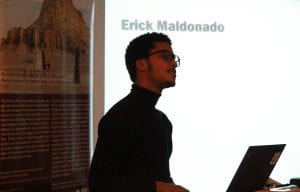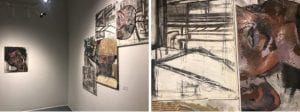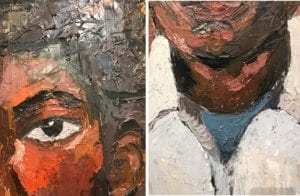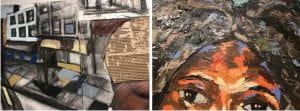Research in Fine Arts
I.D.: Research and Exhibition on African-American Students at UMass Dartmouth
By Erick Maldonado
I am a senior Fine Arts major in the Department of Art and Design. I also minor in Art History in the Department of Art Education, Art History and Media Studies. The goal my OUR-funded project was to highlight African-American student life on campus. I used the fund to do research, purchase painting materials, and organize a solo exhibition, featuring portraits of African-American students on campus. Every portrait is accompanied by a short narrative, describing the thoughts of the student models I chose to paint. My project was supported by Professors Pamela Karimi (Art History) and Bryan McFarlane (Painting) and I am extremely grateful to both of them for their guidance.

Erick Maldonado presents his thoughts on art and issues of displacement to a large crowd of audience at the New Bedford AHA! Festival.
§
As a Dominican-American on campus, I see women and men with different complexions living in complex environments. As students of color, we sometimes feel the barrier of living and communicating within our Institutions of education. At the same time, the African American culture has grown a sense of resiliency against the old racial assumptions. And this is largely thanks to the efforts of those protagonists who made America a better place for all of us. During the Harlem Renaissance, many African-American artists created works that resisted the racial oppression of their time. These artists wanted Black voices and Black stories to be heard, and by doing so they vocalized their own stories to stand up for their rights, by empowering a community and continuing to provide a dialogue, many musicians, artists, writers, and scholars gathered together to make a difference.
It is important to note that during this time there was also a demand for African-Americans to be proud of their racial heritage. In later decades many African-American artists continued to voice their perspective regarding racial oppression. For example, Betye Saar made The Liberation of Black Jemima. By creating an image of Aunt Jemima inside of a frame with a Caucasian child on her hip, Saar used iconographic imagery to state and comment on African-American women and their labor in American history. Romare Bearden, an African-American painter, developed a vocabulary with sudden burst of bright hues that at the time helped depict African-American men and women. His portraits represented black commonalities and helped address African-American living conditions. Lastly, our contemporary, Kara Walker, uses silhouettes and folklore to frame the complex social and living conditions of slaves and slave masters. These artists continue to inspire me to turn history into art and to use the beautiful language of art to address important issues in Black communities.
The ongoing political and racial issues that continue to develop mayhem in this country is what I planned to comment on through this research project that led to a solo exhibition, titled ID. In particular, I wanted to be able to give a strong voice to those UMD students who feel incapable of expressing themselves.
§
 Erick Maldonato’s solo show, I.D., at the 224 Gallery, UMass Dartnmouth.
Erick Maldonato’s solo show, I.D., at the 224 Gallery, UMass Dartnmouth.
Facing the everyday horror of trying to communicate stories, purposes, and lives, my exhibit is a reflection of my identity. My subjects include students from campus who have succeeded in bringing awareness to blackness, continue to inspire and change the frame of blackness on campus, and who elude and conspire a tradition of black representation that also emits the beauty of the community on campus. My overall vision of my project was to unite a group of people in the common goal of embracing culture. As evident due to our country’s divide, Black students are easily more targeted. This OUR-funded exhibit allowed me to create a dialogue where students were able to use their voice to express their identity and culture. Through my paintings and the interviewed that ensued students were able to communicate who they are. Black students are now more than ever are afraid to submerse themselves in a controversial dialogue. Therefore, I wanted to create paintings that would help project their narratives.


Details of Erick Maldonato’s paintings at the 224 Gallery, UMass Dartnmouth.
§
It was truly an honor to be offered an OUR grant in Spring 2017. This successful experience gave me the courage and confidence to apply for external grants. And I am particularly grateful to my professors Pamela Karimi (Art History) and Suzanne Schireson (Painting), who encouraged me to apply and supported my application. The following summer, I applied and received a Mellon Summer Internship at RISD Museum. My position at the museum was with the Contemporary Art department, where I worked closely with Richard Brown Baker, Curator of Contemporary Art, Dominic Molon and Nancy Prophet’s fellow Amber Lopez.
Some of my tasks included overseeing works and maintaining files of nearly hundreds of objects in the collection and preparing research of works for future exhibitions in the galleries. I learned so much from this program. RISD Museum’s Andrew W. Mellon summer internship program introduced me to museum work, the professional skills necessary to work in the arts, and the functionalities inside a museum. This experience shifted my perspective of how I view myself as an artist. The busy, continuous and challenging cycle of distributing art and curating work is one where it’s diligent, practice is valued, and production is a priority. One of the most exciting experiences in the museum was creating my own program for RISD’s Third Thursday. Third Thursday, is an open night where the museum audiences engage more with the collection. My program consisted of learning about color relationships and how they impact shape, form, line, symmetry, and space. It was rewarding working with such a community. I value my time in Providence and the exposure to such programs.
§
In conclusion, the Office of Undergraduate Research provided the special skills and tools that I needed to enhance my knowledge of painting, curation and above all African-American life experience. Learning, exploring, and sharing stories of African-Americans in my community has been an advantage; it has helped me provide other students with an opportunity to find a space to express themselves. This project enabled me to become a better curator, painter and even artist. Above all, it helped me become a critical thinker; it allowed me to appreciate the importance of art historical and anthropological research and to want to encourage others to question the world we live in and instill a sense of pride in black communities.

